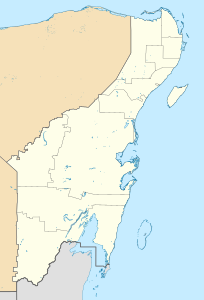Sistema Dos Ojos
| Sistema Dos Ojos
|
||
|---|---|---|
|
Cenote Dos Ojos |
||
| Location: | Quintana Roo , Mexico | |
|
Geographic location: |
20 ° 19 '28.9 " N , 87 ° 23' 31.2" W | |
|
|
||
| Geology: | limestone | |
| Type: | Water cave, stalactite cave | |
| Discovery: | 1986 | |
| Overall length: | 82.435 kilometers | |
| Level difference: | -119.1 meters | |
| Particularities: | world's third longest underwater cave | |
| Website: | www.cenotedosojos.com | |
The Sistema Dos Ojos ( Spanish : Two Eyes ) is an underwater cave system on the Caribbean coast of the Yucatán Peninsula in the Mexican state of Quintana Roo , north of Tulum .
exploration
The Spanish name refers to the two neighboring cenotes that share a common cavern zone. The exploration of the cave system began from these cenotes.
The documented length of the system is 82.4 km; it communicates with the surface through 28 cenotes. The Sistema Dos Ojos is the third longest known underwater cave system in the world after the Sistema Ox Bel Ha and the Sistema Sac Actun . Research into Dos Ojos began in 1986 and is ongoing. At 119.1 m, Dos Ojos is home to the deepest cave passage in Quintana Roo, "The Pit", discovered in 1996 and 1500 m from the main entrance . Dos Ojos lies north and roughly parallel to the Sistema Sac Actun; In August 2012, a connection was found in the Nohoch Nah Chich area via a dry passage .
Research published in January 2018 confirms the connection of the two systems Sac Actun and Dos Ojos, which together with a total length of 310.7 kilometers form the world's longest cave system.
Dos Ojos is an anchialine cave, i. H. the lower lying sea water is overlaid by fresh and brackish water; The system's cenotes close to the coast are also influenced by the tides according to the principle of communicating tubes . The connection to the karst spring on the coast has not been found, although in dyeing tests a significant drain the lagoon Caleta Xel-Ha was detected. The water temperature averages 25 ° C with excellent visibility, as the rainwater is filtered through the limestone and the only thin layer of humus means that there is little tannin input .
fauna
Outside the daylight zone , blind cave fish Typhichthys spec. in front. Two species of Remipedia have been identified in the area of the halocline . The cave inventory contained gomphotheria as well as burned human bones and objects left behind by humans, such as ceramics, as well as wall paintings.
Tourism and Trivia
Dos Ojos Cenotes are a popular snorkeling and grotto diving spot that is typically visited by more than a hundred tourists daily. Dos Ojos became known to a wider public in 2001 through the IMAX film Journey Into Amazing Caves and in 2006 through the BBC documentary Planet Earth . Parts of the film The Cave were shot in Dos Ojos.
literature
- Steve Gerrard: The Cenotes of the Riviera Maya . 2000, ISBN 0-9677412-0-3 (English).
Web links
- Underwater Diving at Dos Ojos (English)
- Journey Into Amazing Caves in the Internet Movie Database (English)
Individual evidence
- ↑ Bob Gulden, Jim Coke: World longest underwater caves. In: Geo2 Committee on Long and Deep Caves. National Speleological Society (NSS), March 26, 2013, accessed June 30, 2013 .
- ↑ a b Long underwater caves in Quintana Roo Mexico. National Speleological Society, Quintana Roo Speleological Survey , June 23, 2013, accessed June 30, 2013 .
- ^ Bob Gulden: Worlds longest caves. In: GEO2 Committee on long and deep caves. NSS, June 20, 2013, accessed June 30, 2013 .
- ↑ a b press report Berliner Zeitung
- ↑ Patricia A. Beddows: Yucatán Phreas, Mexico . In: J. Gunn (Ed.): Encyclopaedia of Cave and Karst Science . tape 2 . Fitzroy Dearborn / Taylor and Francis, New York 2004, ISBN 1-57958-399-7 , pp. 1677-1681 .
- ↑ Biospeleology: The Study of Cave Adapted Life. National Speleological Society, Quintana Roo Speleological Survey, December 1, 2002, accessed January 13, 2011 .

